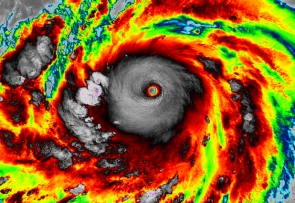
Cyclone Phailin in India
The Cyclone Phailin is striking India. Dr. Shrikant Limaye, Vice-President of the IAPG, asks to publish a "Guidelines document" for disaster management for cyclones.
Please, kindly forward the guidelines to your colleagues and friends in areas affected by cyclones.
Thank you.
*************************
Guidelines for disaster management for cyclones
The actions that need to be taken in the event of a cyclone threat can broadly be divided into four classes, viz., (i) immediately before the cyclone season; (ii) when cyclone alerts and warnings are on; (iii) when evacuations are advised; and (iv) when the cyclone has crossed the coast.
(i) Before the cyclone season
Check the house; secure loose tiles, carry out repair works for doors and windows Remove dead woods or dying trees close to the house; anchor removable objects like lumber piles, loose tin sheds, loose bricks, garbage cans, sign-boards etc. which can fly in strong winds Keep some wooden boards ready so that glass windows can be boarded if needed Keep a hurricane lantern filled with kerosene, battery operated torches and enough dry cells Demolish condemned buildings Keep some extra batteries for transistors Keep some dry non-perishable food always ready for emergency use
(ii) When the cyclone starts
Listen to the radio (All India Radio stations give weather warnings).
Keep monitoring the warnings. This will help you to prepare for a cyclone emergency.
Pass on the information to others.
Ignore rumors and do not spread them; this will help to avoid panic situations.
Believe in the official information
When a cyclone alert is on for your area continue normal working but stay alert to the radio warnings.
Remember that a cyclone alert means that the danger is within 24 hours. Stay alert.
When your area is under cyclone warning get away from low-lying beaches or other low-lying areas close to the coast Leave early before your way to high ground or shelter gets flooded Do not delay and run the risk of being marooned If your house is securely built on high ground take shelter in the safer part of the house. However, if asked to evacuate do not hesitate to leave the place.
Board up glass windows or put storm shutters in place.
Provide strong suitable support for outside doors.
If you do not have wooden boards handy, paste paper strips on glasses to prevent splinters. However, this may not avoid breaking windows.
Get extra food, which can be eaten without cooking. Store extra drinking water in suitably covered vessels.
If you are to evacuate the house move your valuable articles to upper floors to minimize flood damage.
Have hurricane lantern, torches or other emergency lights in working conditions and keep them handy.
Small and loose things, which can fly in strong winds, should be stored safely in a room.
Be sure that a window and door can be opened only on the side opposite to the one facing the wind.
Make provision for children and adults requiring special diets.
If the centre of the cyclone is passing directly over your house there will be a lull in the wind and rain lasting for half and hour or so. During this time do not go out; because immediately after that very strong winds will blow from the opposite direction.
Switch off electrical mains in your house.
Remain calm.
(iii) When evacuation is instructed
Pack essentials for yourself and your family to last you a few days, including medicines, special foods for babies and children or elders.
Head for the proper shelter or evacuation points indicated for your area.
Do not worry about your property
At the shelter follow instructions of the person in charge.
Remain in the shelter until you have been informed to leave
(iv) Post-cyclone measures
You should remain in the shelter until informed that you can return to your home.
You must get inoculated against diseases immediately.
Strictly avoid any loose and dangling wires from the lamp posts.
If you are to drive, drive carefully.
Clear debris from your premises immediately.
Report the correct loss to appropriate authorities.
